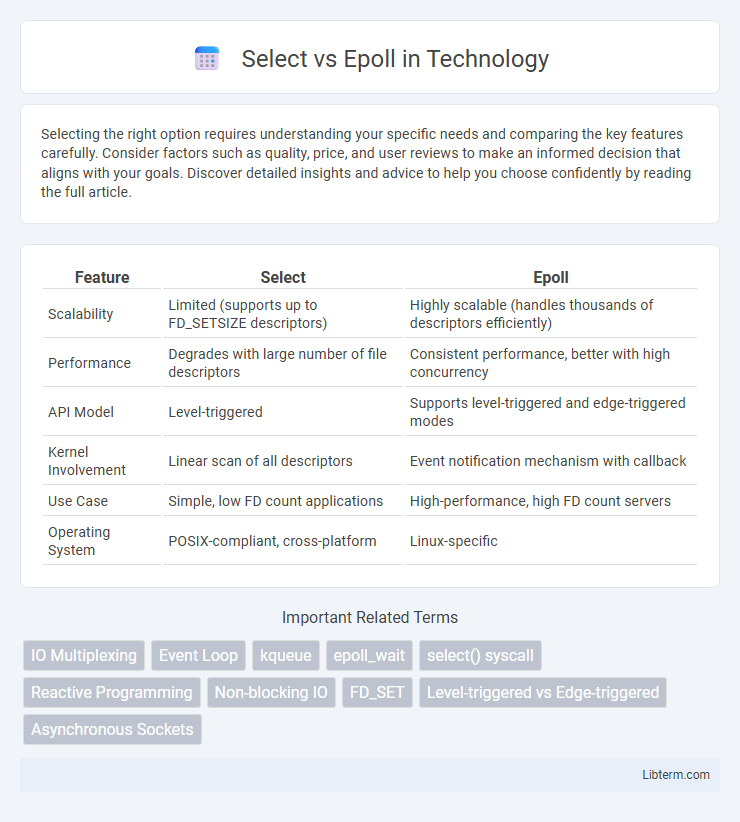Selecting the right option requires understanding your specific needs and comparing the key features carefully. Consider factors such as quality, price, and user reviews to make an informed decision that aligns with your goals. Discover detailed insights and advice to help you choose confidently by reading the full article.
Table of Comparison
| Feature | Select | Epoll |
|---|---|---|
| Scalability | Limited (supports up to FD_SETSIZE descriptors) | Highly scalable (handles thousands of descriptors efficiently) |
| Performance | Degrades with large number of file descriptors | Consistent performance, better with high concurrency |
| API Model | Level-triggered | Supports level-triggered and edge-triggered modes |
| Kernel Involvement | Linear scan of all descriptors | Event notification mechanism with callback |
| Use Case | Simple, low FD count applications | High-performance, high FD count servers |
| Operating System | POSIX-compliant, cross-platform | Linux-specific |
Introduction to I/O Multiplexing
Select and epoll are Linux I/O multiplexing mechanisms designed to monitor multiple file descriptors for readiness to perform I/O operations. Select has limitations on the maximum number of file descriptors it can monitor and incurs overhead from scanning bitmaps, while epoll efficiently handles large numbers of descriptors using event-based notification and scalable kernel-level event polling. I/O multiplexing allows concurrent handling of multiple connections or streams within a single thread, improving server scalability and resource utilization.
Overview of Select and Epoll
Select and epoll are I/O multiplexing mechanisms used in Unix-like operating systems to monitor multiple file descriptors for readiness. Select operates by scanning a fixed-size file descriptor set, which limits scalability and performance in large-scale applications. Epoll uses an event-driven approach with edge-triggered notifications, providing higher efficiency and better handling of numerous simultaneous connections.
How Select Works
Select works by monitoring multiple file descriptors to see if any are ready for I/O operations, using fixed-size fd_set arrays that limit scalability and performance. It performs a linear scan through these sets during each call, which increases overhead as the number of file descriptors grows. This method is less efficient compared to epoll, especially in high-concurrency environments with many simultaneous connections.
How Epoll Works
Epoll operates by monitoring multiple file descriptors using an event-driven interface that efficiently scales with numerous concurrent connections. It employs a kernel-space event poll mechanism, where users register interest in specific file descriptors and receive notifications only when events occur, minimizing overhead compared to select's linear scanning. This design allows epoll to handle thousands of simultaneous events with low latency and reduced CPU usage, making it ideal for high-performance network servers.
Key Differences Between Select and Epoll
Select uses a fixed-size file descriptor set and scans it linearly, limiting scalability to a few hundred descriptors, whereas epoll handles large numbers of file descriptors efficiently with an event-driven model. Epoll uses a kernel-space event notification mechanism that reduces overhead by only returning ready file descriptors instead of checking all, unlike select's linear polling. Select copies file descriptor sets between user space and kernel space on each call, causing performance bottlenecks, while epoll maintains registered descriptors in the kernel, resulting in better CPU and memory efficiency for high-concurrency applications.
Performance Comparison: Select vs Epoll
Epoll demonstrates superior performance over Select in handling large numbers of file descriptors due to its O(1) scalability, whereas Select suffers from O(n) complexity, leading to increased CPU usage and latency as the descriptor set grows. Epoll uses an event-driven mechanism that efficiently notifies only active file descriptors, reducing overhead and context switching compared to Select's need to iterate through all possible descriptors. This makes Epoll the preferred choice for high-performance network servers and applications requiring efficient I/O multiplexing under heavy load.
Scalability in High-Concurrency Environments
Select system calls have limited scalability in high-concurrency environments due to a fixed maximum file descriptor limit and linear scanning of descriptors, resulting in increased CPU usage as the number of connections grows. Epoll is specifically designed for scalability, featuring an event-driven architecture that handles thousands of concurrent connections efficiently by monitoring only active file descriptors. This makes epoll a superior choice for applications requiring high throughput and low latency in large-scale network servers.
Pros and Cons of Select
Select system call supports monitoring multiple file descriptors for I/O readiness and is widely compatible across UNIX-like systems, making it a reliable choice for simple applications. Its limitations include a fixed maximum number of file descriptors (typically 1024), which restricts scalability in high-concurrency environments. Performance degrades with large descriptor sets due to linear scanning, leading to increased CPU usage compared to more efficient mechanisms like epoll.
Pros and Cons of Epoll
Epoll offers high scalability and efficiency for monitoring large numbers of file descriptors, making it ideal for high-performance servers and applications requiring non-blocking I/O operations. It supports edge-triggered and level-triggered event notification, providing flexibility and reducing overhead compared to select's linear scanning. However, epoll's Linux-specific implementation limits cross-platform compatibility, and its complexity can introduce a steeper learning curve for developers unfamiliar with event-driven programming models.
Choosing Between Select and Epoll: Best Practices
When choosing between Select and Epoll, prioritize Epoll for applications requiring high scalability and efficient event handling with thousands of file descriptors. Select is suitable for simpler applications with limited simultaneous connections due to its smaller overhead and widespread compatibility. Developers should consider operating system support, expected connection count, and performance requirements to select the optimal I/O multiplexing mechanism.
Select Infographic

 libterm.com
libterm.com